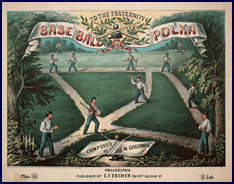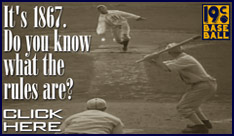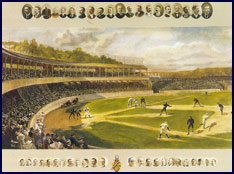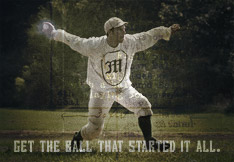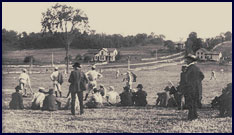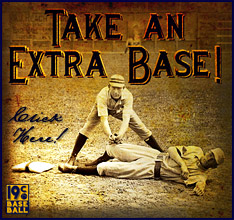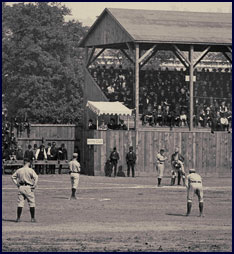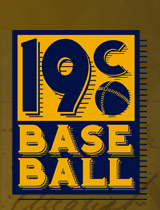Evolution of 19th Century Baseball Rules
erhaps no other American sport has had the extensive number of rule changes that have occurred during the evolution of base ball. Rarely has one aspect of the game under gone only one change. These changes were due to the following factors. The players and managers learned how to circumvent the rules almost yearly, the players became better athletes which required the game to be constantly balanced between offense and defense and the owners wanted an appealing game to their paying patrons. What follows is a synopsis of rule changes that have occurred from 1845–1900. Click here for The Rules of the Game: A Compilation of the Rules of Baseball 1845–1900.
1845
The first important set of written rules was scribed by Alexander Cartwright, of the Knickerbocker Base Ball Club, and published on September 20, 1845. These 20 rules became known as the "Knickerbocker Rules." The "original 20 rules of baseball" were not very specific and only 14 actually were rules pertaining to the field and the play. One significant rule, Rule 13, stated that a player could not be put out by being hit by a thrown ball.
1854
Prior to the famous Base Ball Convention in 1857 was a meeting that occurred between three New York teams on April 1, 1854, in New York City. The teams in attendance were Knickerbocker, Gotham and the Eagle clubs and they revised the "original 20 Rules." One important addition was rule 13 which stated that the first "striker" or batter of the following inning would be the batter who proceeds the player who made the third "hand," or out.
1857
The Base Ball Convention of 1857 held in New York on January 22, by former Knickerbocker President Daniel "Doc" Adams, was the first convention of its kind. Over a dozen clubs sent delegates to the meetings. During this convention Adams was elected President of the Convention and headed the Committee on Rules and Regulations.
Adams changed the length of the game to nine equal innings, instead of declaring the first team to score 21 "aces" or runs, the winner. Adams also declared that five innings must be played to be declared a game.
He set the distance between bases at 30 yards. It has been assumed that the distance was 30 paces between all bases although this distance was never specified in the original Knickerbocker Rules. The only mention of distance is listed in Rule 4 and states; "The bases shall be from "home" to second base, 42 paces; from first to third base, 42 paces, equidistant."
The definition of a pace from An American Dictionary of the English Language, by Noah Webster, 1828: Pace: "1. A step. 2. The space between the two feet in walking, estimated at two feet and a half. But the geometrical pace is five feet, or the whole space passed over by the same foot from one step to another." The definition was not changed for Webster's 1853-revised edition) This means that the distance from home to second would have been 105 feet and the Cartwright base paths would have been 74.25 feet.
The pitching distance was also not described in the Knickerbocker Rules. Adams set the distance from the 12' pitcher's line (which is centered to an imaginary line that is between home base and second base and extends from third to first) to home base at 45 feet.
It was agreed upon that if the striker swung and missed at three pitched balls and the third pitched ball was caught on the first bound or on the fly, the batter was out. If it was not caught on the first bound or the fly the batter must attempt to "make his first," or run to first.
No ace or base could be made upon a foul ball, or when a fair ball has been caught without having touched the ground; and the ball shall, in both instances, be considered dead and not in play, until it shall first have been settled in the hands of the pitcher. When a fair ball has been caught without having touched the ground, the players running the bases shall have the privilege of returning to them.
Adams also advocated the catching a ball on the fly to put a batter out, but was rejected.
1858
For the first time the umpire is allowed to call strikes on a batter that repeatedly refuses not swing at good balls. The umpire was required to warn the striker before calling a strike. After three strikes were called, the batter was bound to "make his run" to first base if the last called strike was not caught by the catcher on the fly or first bound.
1860
The striker is required to stand on a line that extends three feet on either side of home base and is parallel to the pitcher's line.
The umpire was instructed to warn a batter, before calling strikes, if he repeatedly did not strike at fair pitched balls. After three called strikes and the last strike caught on the first bound or the fly the batter was out. If the ball was not caught on the first bound or the fly the batter had to make his first.
The Rules of the Game: A Compilation of the Rules of Baseball 1845–1900 ![]()
